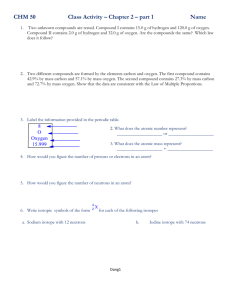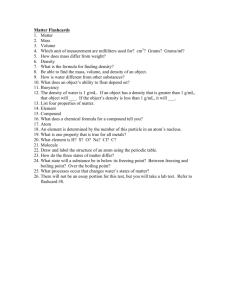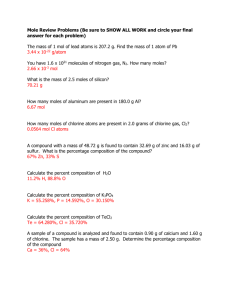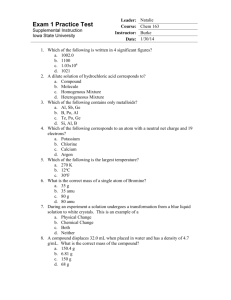Final Exam Review: The final exam will consist of 60 of the following
advertisement
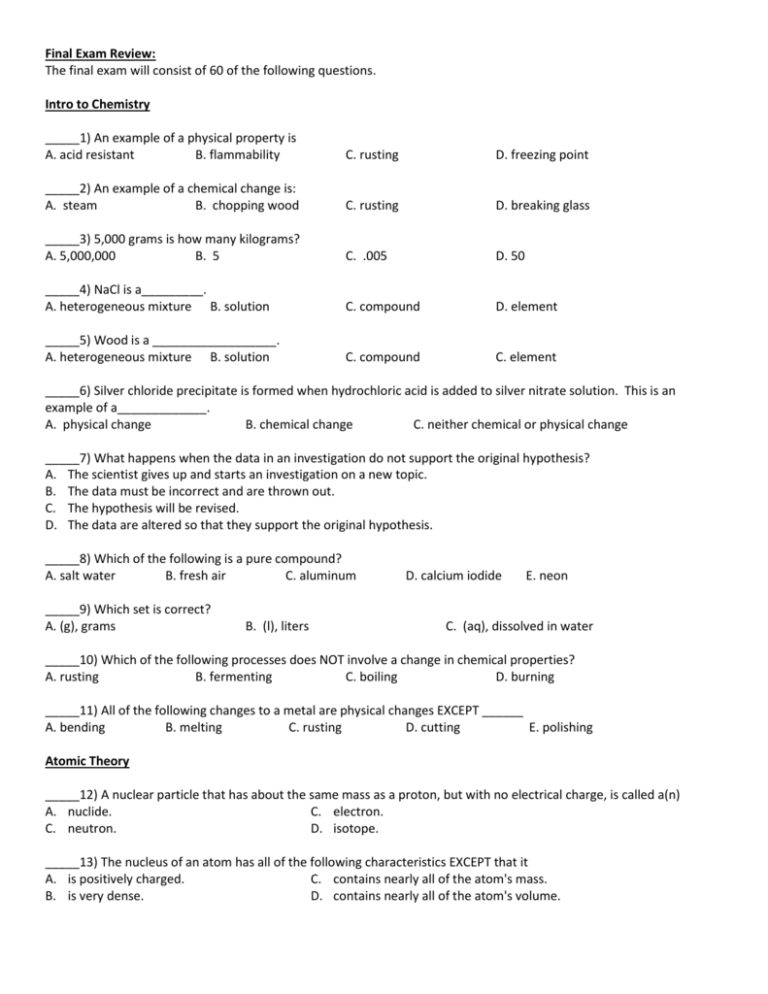
Final Exam Review: The final exam will consist of 60 of the following questions. Intro to Chemistry _____1) An example of a physical property is A. acid resistant B. flammability C. rusting D. freezing point _____2) An example of a chemical change is: A. steam B. chopping wood C. rusting D. breaking glass _____3) 5,000 grams is how many kilograms? A. 5,000,000 B. 5 C. .005 D. 50 _____4) NaCl is a_________. A. heterogeneous mixture B. solution C. compound D. element _____5) Wood is a __________________. A. heterogeneous mixture B. solution C. compound C. element _____6) Silver chloride precipitate is formed when hydrochloric acid is added to silver nitrate solution. This is an example of a_____________. A. physical change B. chemical change C. neither chemical or physical change _____7) What happens when the data in an investigation do not support the original hypothesis? A. The scientist gives up and starts an investigation on a new topic. B. The data must be incorrect and are thrown out. C. The hypothesis will be revised. D. The data are altered so that they support the original hypothesis. _____8) Which of the following is a pure compound? A. salt water B. fresh air C. aluminum _____9) Which set is correct? A. (g), grams B. (l), liters D. calcium iodide E. neon C. (aq), dissolved in water _____10) Which of the following processes does NOT involve a change in chemical properties? A. rusting B. fermenting C. boiling D. burning _____11) All of the following changes to a metal are physical changes EXCEPT ______ A. bending B. melting C. rusting D. cutting E. polishing Atomic Theory _____12) A nuclear particle that has about the same mass as a proton, but with no electrical charge, is called a(n) A. nuclide. C. electron. C. neutron. D. isotope. _____13) The nucleus of an atom has all of the following characteristics EXCEPT that it A. is positively charged. C. contains nearly all of the atom's mass. B. is very dense. D. contains nearly all of the atom's volume. _____14) Isotopes of an element contain different numbers of A. electrons. C. neutrons. B. protons. D. nuclides. _____15) The total number of protons and neutrons in the nucleus of an atom is its A. atomic number. C. mass number. B. Avogadro constant. D. number of neutrons. _____16) Chlorine has atomic number 17 and mass number 35. It has A. 17 protons, 17 electrons, and 18 neutrons. B. 35 protons, 35 electrons, and 17 neutrons. C. 17 protons, 17 electrons, and 52 neutrons. D. 18 protons, 18 electrons, and 17 neutrons. _____17) For an electron in an atom to change from the ground state to an excited state, A. energy must be released. B. energy must be absorbed. C. radiation must be emitted. D. the electron must make a transition from a higher to a lower energy level. _____18) What is the electron configuration for nitrogen, atomic number 7? A. 1s2 2s2 2p3 C. 1s2 2s3 2p1 2 3 2 B. 1s 2s 2p D. 1s2 2s2 2p2 3s1 _____19) The elements whose electron configurations end with s2 p5 in the highest occupied energy level belong to Group A. 3. C. 10. B. 7. D. 17. _____20) The most characteristic property of the noble gases is that they A. have low boiling points. C. are gases at ordinary temperatures. B. are radioactive. D. are largely unreactive. _____21) Rutherford’s gold foil experiment provided evidence for which of the following statements? A. Negative and positive charges are spread evenly throughout an atom. B. Alpha particles have a positive charge. C. Gold is not as dense as previously thought. D. There is a dense, positively charged mass in the center of an atom. _____22) Which scientist said the atom is mostly space? A. Bohr b. Einstein C. Rutherford D. Mendeleev _____23) An atom has 34 protons, 34 electrons, and 45 neutrons. This atom has an atomic number of: A. 34 B. 45 C. 68 D. 79 _____24) Element 38 is a/an ____________ A. transition metal B. halogen C. Representative metal D. synthetic element _____25) The noble gas in the following group is __________. A. hydrogen B. oxygen C. neon D. fluorine _____26) The mass and charge of a neutron are approximately ___________. A. 0 amu and +1 B. 1 amu and 0 C. 1 amu and -1 D. 0 amu and 0 _____27) An atom of an element is being examined. The element is a member of group VI and of period number 3. What oxidation would you expect it to form when it ionizes? A. +3 B. -3 C. -2 D. +4 _____28) Atoms with the same number of protons but different numbers of neutrons are A. isomers B. ions C. alotropes D. isotopes Use the following information to answer questions 29 - 31. An atom of Magnesium has a +2 charge and a mass number of 25. _____29) This atom has _____protons. A. 10 B. 12 C. 13 D. 14 E. 25 _____30) This atom has _______electrons. A. 10 B. 12 C. 13 D. 14 E. 25 _____31) This atom has ______neutrons. A. 10 B. 12 C. 13 D. 14 E. 25 Use this information to answer questions 32 - 35. An atom of element “X” has 34 protons and 47 neutrons. It is neutral. _____32) What is element “X”? A. aluminum B. selenium C. silver D. thallium _____33) How many electrons does it have? A. 13 B. 34 C. 47 D. 81 _____34) What is the atom’s mass number? A. 13 B. 34 C. 47 D. 81 _____35) What is the atom’s atomic number? A. 13 B. 34 C. 47 D. 81 _____36) Dalton's theory essentially agreed with the present atomic theory EXCEPT for the statement that A. all matter is made up of small particles called atoms. B. atoms are not divided in chemical reactions. C. atoms of the same element are chemically alike. D. all atoms of the same element have the same mass. _____37) What element has the electron configuration ending of 1s1? A. oxygen B. hydrogen C. sulfur D. neon _____38) The mass number of an element is equal to ______ A. the total number of electrons in the nucleus C. the total number of protons and neutrons in the nucleus B. less than twice the atomic number D. a constant number for the lighter elements Bonding _____39) Argon, krypton, and xenon are A. alkaline earth metals. B. noble gases. C. actinides. D. lanthanides. _____40) A chemical bond resulting from the electrostatic attraction between positive and negative ions is called a(n) A. covalent bond. C. charged bond. B. ionic bond. D. dipole bond. _____41) A covalent bond results when ____ are shared. A. ions C. electrons B. Lewis structures D. dipoles _____42) Nonpolar covalent bonds are not common because A. one atom usually attracts electrons more strongly than the other. B. ions always form when atoms join. C. the electrons usually remain equally distant from both atoms. D. dipoles are rare in nature. _____43) The electrons involved in the formation of a chemical bond are called A. dipoles. C. Lewis electrons. B. s electrons. D. valence electrons. _____44) Atoms are ____ when they are combined. A. more stable C. not bound together B. less stable D. at a high potential energy _____45) An octet is equal to A. 2. B. 4. C. 5. D. 8. _____46)The electron configuration of nitrogen is 1s2 2s2 2p3. How many more electrons does nitrogen need to satisfy the octet rule? A. 1 C. 5 B. 3 D. 8 _____47) A positive ion is known as a(n) A. ionic radius. B. valence electron. C. cation. D. anion _____48) A negative ion is known as a(n) A. ionic radius. B. valence electron. C. cation. D. anion. _____49) What is the metallic ion in iron(II) chloride? A. Ir+2 C. Fe+2 -2 B. Cl D. Cl-1 _____50)What is the formula for barium hydroxide? A. BaOH C. Ba(OH)2 B. BaOH2 D. Ba(OH) _____51) What is the formula for silicon dioxide? A. SO2 C. Si2O B. SiO2 D. S2O _____52) What is the formula for tin(IV) sulfate? A. Sn(SO4)4 C. Sn2(SO4)4 B. Sn2(SO4)2 D. Sn(SO4)2 _____53) Name the compound Zn3(PO4)2 A. zinc potassium oxide B. trizinc polyoxide C. zinc phosphate D. zinc phosphite _____54) Name the compound CuCO3. A. copper(I) carbonate B. copper (II) carbonate C. copper(III) carbonate D. copper carbon trioxide _____55) What is the chemical name for the compound H2O? A. hydroxide C. dihydrogen monoxide B. dihydrogen oxide D. water _____56) What is the formula mass of magnesium chloride, MgCl2? A. 46 amu C. 95.211 amu B. 59.763 amu D. 106.354 amu _____57) Which of these elements usually exists as a diatomic molecule? A. hydrogen B. oxygen C. nitrogen D. all of these _____58) Which of these has –1 charge when it forms an ion? A. Na B. Cl C. O D. Kr _____59) Which of these has a tendency to lose two electrons? A. Na B. Sr C. Al D. Kr _____60) Which of these forms a +3 ion. A. Na B. Fr C. Al D. Ne _____61) Which of these forms a –2 ion? A. Na B. Mg C. N D. S _____62) When it ionizes, calcium would have a charge of __________. A. +1 B. +2 C. -2 D. 0 _____63) What is the formula for potassium oxide? A. KO B. K2O C. KO2 D.K3O2 _____64) What is the formula for lead (II) carbonate? A. PbCO3 B. Pb2CO3 C. Pb(CO3)2 D. Pb3 (CO3)2 _____65) K2CO3 is named ___________ A. potassium carboxide B. sodium carbonide _____66) The number of sulfur atoms in the formula Al2(SO4)3 is A. one B. three C. four C. potassium carbonate D. twelve _____67) What is the formula for the compound formed by calcium ions and chloride ions? A. CaCl C. CaCl3 B. Ca2Cl D. CaCl2 _____68) If a combination reaction takes place between potassium and chlorine, what is the product? A. KCl B. KCl2 C. K2Cl D. PCl E. PCl2 _____69) An -ate or -ite at the end of a compound name usually indicates that the compound contains ______ A. fewer anions than cation C. neutral molecules E. only two elements B. hydroxide or cyanide ions D. a polyatomic ion Reactions _____70) Which coefficients correctly balance the formula equation CaO + H2O → Ca(OH)2? A. 2, 1, 2 C. 1, 2, 1 B. 1, 2, 3 D. 1, 1, 1 _____71) In what kind of reaction do two or more substances combine to form a new compound? A. decomposition reaction C. double-replacement reaction B. ionic reaction D. synthesis reaction _____72) In what kind of reaction does one element replace a similar element in a compound? A. single-replacement reaction C. decomposition reaction B. double-replacement reaction D. ionic reaction _____73) The complete balanced equation for the reaction between zinc hydroxide and acetic acid is A. ZnOH + CH3COOH → ZnCH3COO + H2O. B. Zn(OH)2 + CH3COOH → Zn + 2CO2 +3H2O. C. Zn(OH)2 + 2CH3COOH → Zn(CH3COO)2 + 2H2O. D. Zn(OH)2 + 2CH3COOH → Zn(CH3COO)2+ H2 + O2. _____74) In the equation 2Al(s) + 3Fe(NO3)2 (aq) → 3Fe(s) + 2Al(NO3)3 (aq), iron has been replaced by A. nitrate. C. aluminum. B. water. D. nitrogen. _____75) In a double-replacement reaction, hydrogen chloride and sodium hydroxide react to produce sodium chloride. Another product is A. sodium hydride. C. water. B. potassium chloride. D. hydrogen gas. _____76) The formulas for the products of the reaction between sodium hydroxide and sulfuric acid are A. Na2SO4 and H2O. C. SI4 and Na2O. B. NaSO4 and H2O. D. S + O2 and Na. _____77) What is the balanced equation when aluminum reacts with copper(II) sulfate? A. Al + Cu2S → Al2S + Cu C. Al + CuSO4 → AlSO4 + Cu B. 2Al + 3CuSO4 → Al2(SO4)3 + 3Cu D. 2Al + Cu2SO4 → Al2SO4 + 2Cu _____78) Which of the following equations are correctly written and balanced? A. 2Na + 2H2O 2NaOH + H2 C. Na + H2O NaOH + H B. 2Na + H2O 2NaOH + H2 D. Na + 2H2O 2NaOH + 2H _____79) K2SO4 is called__________ A. potasium sulfide B. potassium sulfite C. potassium sulfate _____80)What type of reaction is represented by the following equation? NaCl + HNO3 NaNO3 + HCl A. synthesis B. decomposition C. single displacement D. phosphorous sulfide D. double displacement _____81) A chemical formula includes the symbols of the elements in the compound and subscripts that indicate… A. the number of moles in each element. B. how many atoms or ions of each type are combined in the simplest unit. C. the formula mass. D. the charges on the elements or ions. _____82) What is the balanced equation for the combustion of sulfur? A. S(s) + O2 (g) SO(g) C. 2S(s) + 3O2 (g) SO3(s) B. S(s) + O2 (g) SO2 (g) D. S(s) + 2O2(g) SO42-(aq) _____83) The reaction Mg(s) + 2HCl(aq) H2(g) + MgCl2(aq) is a A. composition reaction. C. single-replacement reaction. B. decomposition reaction. D. double-replacement reaction. _____84) What is the balanced equation when aluminum reacts with copper(II) sulfate? A. Al + Cu2 S Al2S + Cu C. Al + CuSO4 Al(SO4)3 + Cu B. 2Al + 3CuSO4 Al2(SO4)3 + 3Cu D. 2Al + Cu2SO4 Al2(SO4)3 + 2Cu _____85) What information is NOT given by an overall equation for a chemical reaction? A. the relative numbers of molecules used C. the probable order of the reaction B. the number of atoms participating in the reaction D. the reaction mechanism _____86) Identify the gas in the following reaction. 2 Na (s) + 2 H2O (l) 2 NaOH (aq) + H2 (g) A. Na B. H2O C. NaOH _____87) This symbol (g) indicates A. that heat must be applied B. that the reaction is reversible D. H2 C. an incomplete combustion reaction is formed by the reaction D. The compound/element is a gas _____88) In a chemical reaction the mass of the products A. is less than the mass of the reactants C. is greater than the mass of the reactants B. is equal to the mass of the reactants D. has no relationship to the mass of the reactants _____89)What gas is necessary for all combustion reactions? A. Hydrogen B. Neon C. Oxygen D. Nitrogen Stoichiometry _____90) For the reaction N2 + 3H2 → 2NH3, how many moles of nitrogen are required to produce 18 mol of ammonia? A. 9.0 mol C. 27 mol B. 18 mol D. 36 mol _____91) For the reaction 2Fe + O2 → 2FeO, how many grams of iron oxide are produced from 8.00 mol of iron? A. 71.8 g C. 712 g B. 574 g D. 1310 g _____92) Mercury can be obtained by the following reaction: 4HgS(s) + 4CaO(s) → 4Hg(l) + 3CaS(s) + CaSO4(s) According to this balanced reaction, how many grams of calcium oxide are needed to produce 36.0 g of Hg? A. 10.1 g C. 1.80 g B. 7.56 g D. 36.0 g _____93) When glucose (C16H12O6) is consumed, it reacts with the oxygen (O2) in the body to form carbon dioxide, water, and energy. How many grams of carbon dioxide would be produced if 45 g of (C16H12O6) completely react with oxygen? A. 66 g C. 1.5 g B. 11 g D. 1.8 g _____94) For the reaction 2Na + 2H2O → 2NaOH + H2, how many grams of hydrogen are produced if 120. g of sodium and 80. g of water are available? A. 4.5 g C. 80. g B. 44 g D. 200. g _____95) For the reaction 2Na + Cl2 → 2NaCl, how many grams of sodium chloride can be produced from 500. grams each of sodium and chlorine? A. 112 g C. 409 g B. 319 g D. 825 g _____96) In the reaction A + B → C + D, if the quantity of B is insufficient to react with all of A, A. A is the limiting reactant. C. there is no limiting reactant. B. B is the limiting reactant. D. no product can be formed. _____97) The molecular mass of the compound HNO3 is_________ A. 32 B. 63 C. 91 D. 93 _____98) The density of ethanol is 0.789 grams/mL. What is the volume in mL of 10.0 g of ethanol? A. 12.7mL B. 7.89 Ml C. 0.789 mL D. 1.27 mL _____99) The empirical formula for a compound that is 40% sulfur and 60% oxygen is A. SO B. SO2 C. SO3 D. S2O3 _____100) Two moles of ammonia, NH3, contain _______ molecules. A. 6.02 x 1023 B. 1.204 x 1024 C. 24.24 x 1023 D. 6.02 x 1024 _____101) How many grams would be measured if 0.500 moles of C6H12O6 were needed? A. 180.0g B. 45.0g C. 90.0g D. 320g _____102) The molar mass of an element is the mass of one A. atom of the element. C. gram of the element. B. liter of the element. D. mole of the element. _____103) What is the percentage composition of CF4? A. 20% C, 80% F C. 16.8% C, 83.2% F B. 13.6% C, 86.4% F D. 81% C, 19% F _____104) What is the formula mass of (NH4)2SO4? a. 114.09 amu c. 128.06 amu b. 118.34 amu d. 132.13 amu _____105) The molar mass of CCl4 is 153.81 g/mol. How many grams of CCl4 are needed to have 5.000 mol? A. 5 g C. 769.0 g B. 30.76 g D. 796.05 g _____106) 1.00 moles of C4H10 is burned in excess oxygen. How many moles of CO2 gas is formed? A. 2.00 moles B. 4.00 moles C. 1.00 moles _____107) What is the mass of one mole of AgNO3? A. 170 g B. 270 g C. 640 g D. 2.20 g E. 3.00 g _____108) Metallic copper is formed when aluminum reacts with copper (II) sulfate. According to the following balanced equation: 2 Al + 3 CuSO4 A12(SO4)3 + 3 Cu How many moles of metallic copper can be obtained when 4.0 moles of Al reacts with CuSO4? A. 6.00 moles B. 3.00 moles C. 12.0 moles D. 38 moles E. 57 moles _____109) How many moles of helium atoms are there in 8.00 grams helium atoms A. 2.0 mol B. 5.0 x 10-1 mol C. 4.0 mol D. 2.0 x 101 mol E. 7.2 x 10-47 _____110) Calculate the number of moles of Al2O3 that are produced when 0.60 mol of Fe is produced in the following reaction. 2 A1(s) + 3 Fe0(s) 3 Fe(s) + A12O3(s) A. 0.20 mol B. 0.40 mol C. 0.60 mol D. 0.90 mol E. 1.8 mol Solutions and Solubility _____111) Water in air is an example of which solute-solvent combination? A. gas-liquid C. liquid-liquid B. liquid-gas D. gas-gas _____112) A substance whose water solution conducts a current is a(n) A. nonelectrolyte. C. nonpolar substance. B. electrolyte. D. solute. _____113) Which of the following does NOT increase the rate of dissolving a solid in water? A. raising the temperature C. using larger pieces of solid B. stirring D. crushing the solid _____114) Which of the following will dissolve most rapidly? A. sugar cubes in cold water C. powdered sugar in cold water B. sugar cubes in hot water D. powdered sugar in hot water _____115) The solubility of a substance at a given temperature can be expressed as A. grams of solute. C. amount of solute per amount of solvent. B. grams of solvent. D. grams of water per 100 g of solute. _____116) What is the molarity of a solution that contains 125 g NaCl in 4.00 L solution? A. 0.535 M C. 8.56 M B. 2.14 M D. 31.3 M _____117) How many moles of HCl are present in 0.70 L of a 0.33 M HCl solution? A. 0.23 mol C. 0.38 mol B. 0.28 mol D. 0.47 mol The solubility of materials in liquids depends not only on the nature of the solute and the solvent, but also on temperature. Use the following graph showing solubilities for 51 – 54. _____118) Which of the following has a solubility most sensitive to temperature throughout the range shown. A. NaNO3 C. NaCl B. KNO3 D. NH3 _____119) The solubility of sodium salts is: A. high because sodium is an alkali metal. B. low because sodium combines with anions to make salts. C. dependent on which salt it forms. D. always greater than 20 grams per 100 grams of water. _____120) A 250 g water solution of KNO3 at 50ºC contains how many grams of KNO3 at saturation? A. 80 g C. 30 g B. 200 g D. Insufficient data is provided. _____121) A solution containing equal amounts of NaNO3 and KNO3 is allowed to cool until a white powder begins to appear at the bottom of the flask. That powder is A. KNO3 C. a mixture of both B. NaNO3 D. Insufficient data is provided _____122) In general, as the temperature of a solution composed of a gas in a liquid is increased, the solubility of the gas A. increases B. decreases C. remains the same _____123) Which of the following are weak electrolytes in water? A. ionic compounds that are slightly soluble C. ionic compounds that are soluble B. polar compounds that ionize D. non-polar compounds that do not ionize _____124) What type of compound is always an electrolyte? A. polar covalent B. non-polar covalent Acids & Bases _____125) Acids taste A. sweet. B. sour. C. bitter. D. salty. _____126) Acids generally release H2 gas when they react with A. nonmetals. C. active metals. B. semimetals. D. inactive metals. C. ionic _____127) Bases taste A. soapy. B. sour. C. sweet. D. bitter. _____128) Bases feel A. rough. B. moist. C. slippery. D. dry. _____129) What is an Arrhenius acid? A. a chemical compound that increases the concentration of hydrogen ions in aqueous solution B. a chemical compound that increases the concentration of hydroxide ions in aqueous solution C. a chemical compound that decreases the concentration of hydrogen ions in aqueous solution D. a chemical compound that decreases the concentration of hydroxide ions in aqueous solution _____130) Strong acids are A. strong electrolytes. B. weak electrolytes. C. nonelectrolytes. D. Non-ionized. _____131) A Brønsted-Lowry acid is A. an electron-pair acceptor. B. an electron-pair donor. C. a proton acceptor. D. a proton donor. _____132)In the equation HCl(g) + H2O(l) → H3O+(aq) + Cl–(aq), which species is a Brønsted-Lowry acid? A. HCl C. Cl– B. H2O D. none of the above _____133) A conjugate base is the species that A. remains after a base has given up a proton. B. is formed by the addition of a proton to a base. C. is formed by the addition of a proton to an acid. D. remains after an acid has given up a proton. _____134) Which compound is produced by a neutralization? A. H2O(l) C. Ca(OH)2(s) B. HNO3(aq) D. H3PO4(aq) _____135) What is the concentration of H3O+ in pure water? A. 1 x 10–7 M C. 55.4 M B. 0.7 M D. 1 x 107 M _____136) The pH scale in general use ranges from A. 0 to 1. C. 0 to 7. B. –1 to 1. D. 0 to 14. _____137) The pH of an acidic solution is A. less than 0. B. less than 7. C. greater than 7. D. greater than 14. _____138) The pH of a basic solution is A. less than 0. B. less than 7. C. greater than 7. D. greater than 14. _____139) Calculate the molarity of a Ba(OH)2 solution if 1900 mL is completely titrated by 261 mL of 0.505 M HNO3. A. 0.0173 M C. 0.0322 M B. 0.0254 M D. 0.0347 M _____140)The OH-concentration of a solution with a pH of 3 is A. 1x10-11 B. 1 x10-3 C. 1x103 D. 1 x 1011 _____141) If an atom is neutralized in a titration reaction, what is the pH of the final solution? A. 7 B. below 7 C. above 7 _____142) For a solution to be classified as acidic, the… A. hydrogen-ion concentration must be 10-7 B. hydrogen-ion and hydroxide-ion concentrations must be equal C. hydrogen-ion concentration must be greater than the hydroxide-ion concentration D. the hydrogen-ion concentration must be 7.0 M or greater _____143) Which of the following is a property of an acid? A. sour taste B. non-electrolyte C. strong color D. slippery feel _____144) The products of self-ionization of water are ______ A. H3O+ and H2O B. HO- and 0HC. HO+ and H- D. OH- and H3O+ _____145) According to Bronsted and Lowry, an acid is a proton ________ A. acceptor B. donor C. molecule _____146) A water solution of which compound will turn blue litmus red? A. K2CO3 B. NH4Cl C. NaOH D. HCl _____147) Which of the following reactions illustrates the ionization of water? A. 2H2O H3O+ + OH- B. NaCl Na+ + ClC. HCl + H2O H3O+ + ClD. NaOH Na+ + OH_____148) For the reaction: H2O + NH3 NH4+ + OHThe conjugate acid is + A. NH4 B. OHC. H2O D. NH3 _____149) What products result from a neutralization reaction? A. acids and bases B. water only C. a salt only D. a salt and water _____150) What is the concentration of sulfuric acid if 50 ml of acid is neutralized by 50 ml of 0.1M sodium hydroxide? A. 0.005M B. 0.01 M C. 0.25 M D. 0.10 M Mark “A” if the statement describes an ACID and “B” if the statement describes a BASE. _____151) Slippery to the touch. _____152) Turns litmus red. _____153) Reacts with metals to release hydrogen gas. _____154) Tastes bitter. _____155) Proton donor. _____156) Proton acceptor. _____157) Releases H+ in solution. _____158) Releases OH- in solution. _____159) A solution with a pH of 12. _____160) A solution with a pH of 2.
